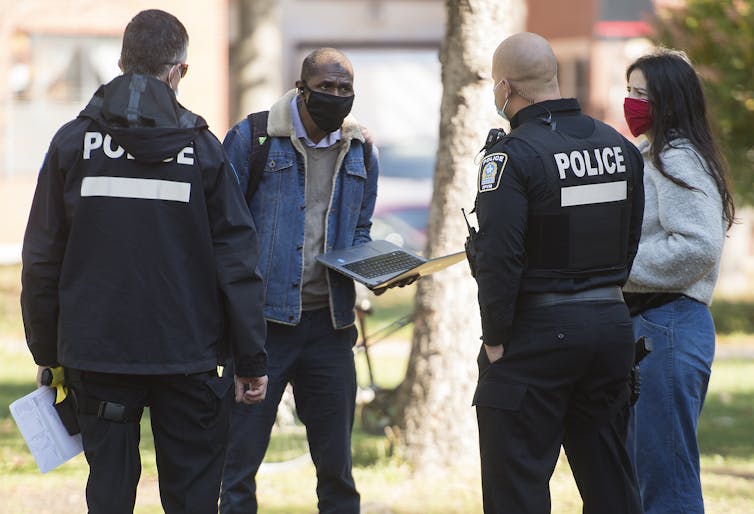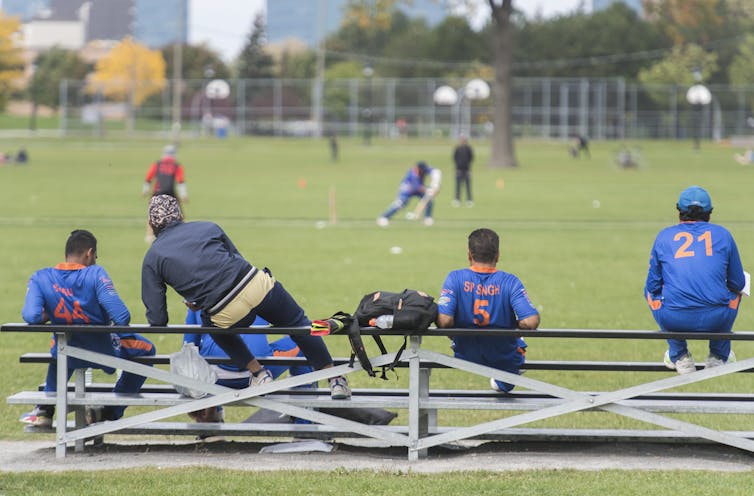Nadha Hassen, York University, Canada
Multiple pandemics have been raging over the past year. Those of us in North America witnessed the convergence of three systemic issues focused on people’s health, green spaces and racial justice.
Black, Indigenous and people of colour face increased surveillance, suspicion, harassment and violence in public green spaces, like parks and ravines. This influences behaviours — who feels comfortable to linger in a park and who is seen as out of place, trespassing or suspicious? The perceptions of who belongs stem in part from a history of parks as spaces for primarily upper class, able-bodied, white men.
The COVID-19 pandemic quickly highlighted the underlying social and health inequities that have always been present. In addition, people in cities have been increasingly seeking public green spaces in the face of lockdowns. Finally, calls for racial justice have been amplified with the increased mainstream awareness of racism — especially anti-Black, anti-Indigenous and anti-Asian racism.
The increased use of green space during the pandemic shows how it is a key part of the process to “build back better” after COVID-19. The UN-Habitat’s recent report “Cities and Pandemics: Towards a More Just, Green and Healthy Future” shares strategies for post-pandemic urban life, but falls short in naming systemic racism as a factor to address.
How can we take an intersectional, anti-racist approach to planning urban green spaces as a public health measure? Policy-makers, planners and public health professionals can learn from critical race and critical theory scholars in pushing for multidisciplinary action.
This is vital to stop upholding harmful practices that are rooted in systemic oppression. This critical framing is a prerequisite to create socially equitable green spaces that benefit public health post-pandemic.
Here are six ideas for policy-makers, city officials, public health, city builders and planners to consider in research, policy and practice:
1. Resist romanticizing nature and green spaces
Public green spaces have the potential to promote physical and mental health. However, there is a tendency to romanticize nature and presume that all green spaces are universally good for everyone.
Green spaces, like other public spaces, are subject to the same social and systemic factors that govern how people navigate and interact within them.

THE CANADIAN PRESS/Graham Hughes
As a racialized person in Toronto, I have been told to “go back home” and received sidelong glances when walking through certain neighbourhoods. As a woman, I have been whistled at and followed in public. As someone with chronic pain, I have had to turn back when confronted with a long flight of stairs.
Not everyone experiences a green space in the same way. The presumption that they do undermines the potential for green spaces to improve health in an equitable way, especially for Black, Indigenous and racialized people.
2. Address the structural determinants of health
Social determinants of health include factors like race, ability, gender and income, whereas the structural determinants of health are the root causes that make those identities subject to health disparities. Structural determinants include racism, white supremacy, ableism, classism, sexism, transphobia and xenophobia.

THE CANADIAN PRESS/Graham Hughes
In Toronto, neighbourhoods are divided along racial and income lines that continue to grow. This divide is the legacy of historical exclusionary policies.
Current policies and processes need to be grounded in principles of equity and anti-oppression to address injustices. Allocating the same resources now does not account for decades of discriminatory practices. Why does one neighbourhood get a playground quickly rebuilt after a fire, where another gets a second-hand playground after years of delays?
3. Engage meaningfully with people who are racialized
An anti-racist approach to creating equitable urban spaces ensures that the needs of racialized communities are being met. Existing urban planning processes and health promotion initiatives around green spaces need to be reimagined to embed racial and social equity in revamping education, theory and practice.
The quantity and quality of green space available in racialized neighbourhoods is lower than in predominantly white and higher-income neighbourhoods, linking back to systemic issues about where green spaces are protected, developed and maintained.
Long-term accountability and transparency are non-negotiable. How do we address hundreds of years of slavery and settler colonialism, especially when it comes to Indigenous lands? Who do we see in leadership positions in government and within institutions? What initiatives get funded? Situations like that of Christian Cooper, a Black man and birdwatcher, who was threatened and had the police falsely called on him, continue to happen.
My current research focuses on the experiences of people who are racialized in public, green spaces in Toronto. My discussions with community members include questions about who gets consulted in city engagement processes and whose concerns are addressed, versus who might be labelled as problematic. Silencing and ignoring certain voices is an insidious and longtime strategy in upholding oppression, including racism, ableism and patriarchy.
4. Expand the concept of access
Although physical access (like ramps, clear access points and signage) is important, the definition of access to green space needs to be expanded to include social access.
There are deeply embedded ideas within western society about who belongs and who is seen as an outsider. These ideas impact people’s experiences in green spaces.
This social access lens must include a nuanced understanding of race relations and a historical understanding of systemic racism in Canada.
5. Build solidarity between groups
While it is important to understand unique group experiences and histories, particularly when it comes to Black and Indigenous people, it is necessary to build solidarity through common ground. An entrenched focus on differences only serves oppressive systems like white supremacy through fragmentation.
Solidarity extends to include LGBTQ+ groups, those who are undocumented, migrant workers and those experiencing poverty and/or homelessness, for instance. Multiple oppressions can exist simultaneously and should not be presented as contradictions.
6. Document and share processes and actions
Documenting both processes and actions is a crucial part of recording histories that often do not make it into mainstream venues. While not always an easy task, this is especially important for community groups pushing for change to document what has taken place, noting both challenges and opportunities for others to learn from and build on in solidarity.

THE CANADIAN PRESS/Frank Gunn
What will the archived narratives and stories from this period of crises be? For example, in Toronto, groups like the Encampment Support Network and the St. James Town Community Co-op are responding to system-driven crises like homelessness and food insecurity, and documenting them in newsletters and social media.
In moving beyond this pandemic, we must critically consider how urban green spaces are a part of moving towards healthier, equitable cities that are racially and socially just.![]()
Nadha Hassen, PhD Candidate and Vanier Scholar, York University, Canada
This article is republished from The Conversation under a Creative Commons license. Read the original article.
Featured image: Green spaces are inequitably distributed across cities: The quality and quantity are lower in racialized neighbourhoods. THE CANADIAN PRESS/Cole Burston

